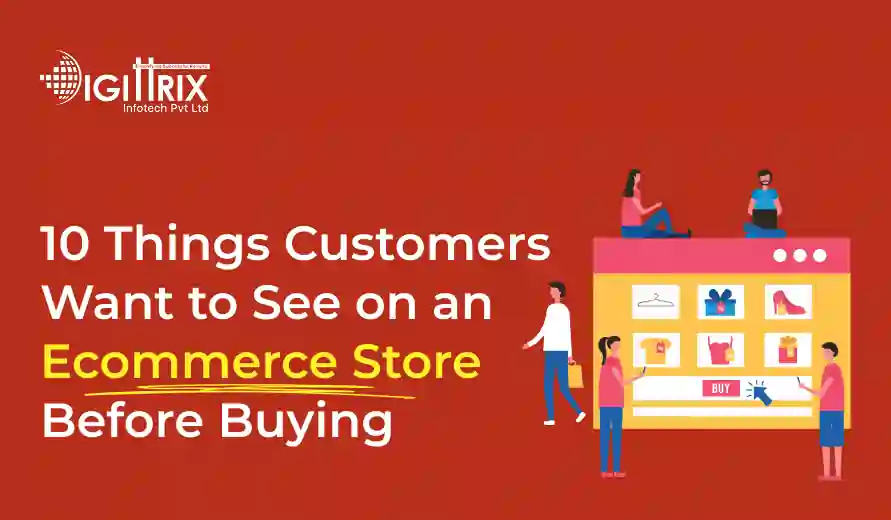Customers judge ecommerce stores on clarity, trust, and convenience. From product details to secure payments, essential features affect buying choices and encourage repeat business.
Highlights
With Over 14 years of Experience in the IT Field, Helping Companies Optimise there Products for more Conversions
 Online shopping has become a common part of daily life. People buy clothes, electronics, groceries, and even medicines through online platforms. But with so many online stores available, customers are more selective. They no longer purchase just because a product is listed online. Instead, they carefully evaluate whether a store appears trustworthy, easy to navigate, and worth their money. For ecommerce owners, this means that how a store is built, designed, and presented plays a major role in convincing visitors to make a purchase.
Online shopping has become a common part of daily life. People buy clothes, electronics, groceries, and even medicines through online platforms. But with so many online stores available, customers are more selective. They no longer purchase just because a product is listed online. Instead, they carefully evaluate whether a store appears trustworthy, easy to navigate, and worth their money. For ecommerce owners, this means that how a store is built, designed, and presented plays a major role in convincing visitors to make a purchase.
In this article, we will discuss the 10 most important things customers want to see on an ecommerce store before making a purchase. Understanding these expectations will help businesses create stores that build trust, encourage more orders, and keep customers coming back.
Looking to scale your online sales? Discover how seamless ERP–e-commerce integration drives accuracy, speed, and repeat business with Digittrix’s expert insight!
The first thing customers look for is detailed product information. Since they can't touch or test the item when shopping online, the description must replace that experience. A good product page should include:
Customers often leave a site if the information is incomplete or confusing. For example, clothing shoppers want a proper size guide, while gadget buyers want details about specifications and compatibility. Providing transparent information clears up doubts and lowers product returns.
Visual appeal is a strong motivator. Customers trust what they see. Clear product photos, lifestyle shots, and brief demo videos boost their confidence in buying.
Here are some practices successful stores follow:
When customers can see products clearly, they feel more confident about spending money. In e-commerce, visuals serve as the closest replacement for the in-store shopping experience.
A complicated or confusing checkout process is one of the main reasons people abandon their shopping carts. Customers want to finish payment in just a few simple steps. Essential features include:
A store can lose significant sales if checkout feels slow or suspicious. That’s why many businesses invest in e-commerce web development to craft smooth, customer-friendly payment flows. Having professional developers design checkout processes helps decrease drop-offs and build trust.
A large number of shoppers use smartphones to browse and purchase products. If a store doesn't load correctly on mobile devices, customers quickly leave. Having a mobile-friendly design is no longer optional—it has become a standard expectation.
Key aspects include:
Some businesses take it further by developing dedicated apps. Professional ecommerce mobile app development enables customers to browse and shop easily on their phones, with benefits like push notifications, one-click login, and saved preferences. An app also helps boost customer loyalty over time.
Before making a purchase, most shoppers want to know what others have experienced. Reviews and ratings increase trust and lower the chance of disappointment.
Why reviews matter:
Stores that permit verified buyers to upload photos with reviews are even more trustworthy. In fact, reviews often impact purchase decisions more than the product description itself.
Nothing frustrates a buyer more than vague delivery timelines. Customers want precise information on when and how their order will arrive. Essential details include:
Customers are more likely to complete a purchase when they know their order will arrive quickly and without hidden costs. Many businesses hire professionals offering custom ecommerce website development to integrate advanced logistics systems, real-time tracking, and shipping calculators into their store. This not only builds trust but also reduces customer complaints.
Since customers cannot touch or test products before purchasing, they want reassurance that returning or exchanging them is simple. A clear return and refund policy is one of the most important factors in building trust.
Best practices include:
If customers perceive difficulty in the return process, they often avoid buying altogether. Clear policies reassure them that they won’t lose money if the product doesn’t meet expectations.
Online fraud is a major issue for shoppers. Customers want assurance that their payment details, personal information, and passwords are secure. To build trust, ecommerce stores must:
Hiring professionals for ecommerce web development ensures these features are implemented properly. A secure store not only protects customers but also promotes repeat orders because buyers feel confident saving payment details.
Customers often prefer shopping at stores that feel personal, not just transactional. A brief brand story, a “Meet the Team” section, or even social media links help foster a connection.
Additionally, buyers want convenient contact options if they encounter an issue. Providing:
...makes a significant difference. When customers see that support is available, they feel more comfortable completing their order.
For brands using Shopify, many depend on experts in Shopify app development services to add live chat tools, personalized product recommendations, and other valuable integrations that help customers feel supported throughout every step.
Customers always value getting their money's worth. Stores that provide discounts, coupons, or loyalty points are more likely to keep customers coming back. However, it’s not just about lowering prices.
A strong rewards program can include:
These incentives give customers a reason to return. Many businesses hire a Shopify app developer to build loyalty programs directly into their online store. This way, rewards are tracked automatically, and customers can redeem them easily.
The online marketplace is competitive, and shoppers often leave a site within seconds if the experience feels confusing or untrustworthy. Meeting these 10 expectations is about more than just making sales; it’s about building trust and nurturing long-term relationships with customers.
Whether you’re running a clothing boutique, an electronics shop, or a grocery delivery service, the way your store is designed and managed significantly influences customer perception. Features like clear product details, simple checkout, secure payments, honest reviews, and reliable delivery options all work together to build a store that people trust.
When businesses emphasize simplicity, safety, transparency, and customer-friendly features, they don’t just secure one-time purchases. They build repeat business, greater loyalty, and long-term growth.
Facing hurdles in online sales? Discover Digittrix’s guide to tackling e-commerce challenges and build a smoother, more successful online business!
The digital marketplace is crowded, and customers have endless options. But what makes one store stand out is not just the products it sells—it’s the confidence and comfort it provides before and after purchase.
By highlighting clear product details, visuals, reviews, secure payments, return policies, shipping transparency, customer support, and loyalty programs, businesses can effectively meet customer expectations.
For store owners, working with experts in ecommerce web and app development isn’t just about creating a website or app—it’s about building an online store that customers trust. With the right features, your store will attract visitors and convert them into loyal, repeat customers.
Meeting customer expectations is crucial for running a successful online store. From clear product descriptions and reviews to mobile-friendly shopping, fast shipping, and secure payments—every element helps build customer trust. To do this effectively, you need more than just products; you need a well-designed e-commerce platform.
With over 14 years of industry experience, Digittrix has established itself as a trusted ecommerce app development company in Australia, helping businesses of all sizes build secure, responsive, and growth-focused online stores. Whether you're launching your first store or expanding an existing one, we can assist you in creating a shopping experience that meets customer expectations before they make a purchase.
If you’re ready to create an ecommerce store that customers can trust, contact Digittrix today. Call us at +91 8727000867 or email digittrix@gmail.com to schedule your consultation with our expert technical managers.

Do you need help in Web Development ?




Join over 1500+ businesses we've already helped!
Clear product details help customers understand exactly what they’re buying, reducing confusion and lowering the chances of returns.
A mobile-friendly store makes shopping easier on smartphones, allowing customers to browse, add items, and pay quickly without facing display or navigation issues.
Reviews provide real experiences from other buyers, which increases trust, helps customers feel confident, and often influences final purchase decisions.

©2025Digittrix Infotech Private Limited , All rights reserved.